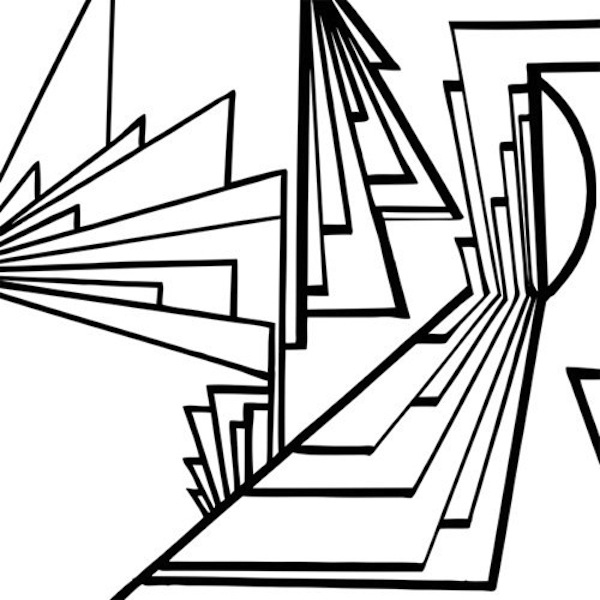CD Review: Shabazz Palaces’ “Lese Majesty” — Out-of-This-World Hip-Hop
Some listeners are undoubtedly going to dismiss Lese Majesty as a collection of vignettes or motifs, formless for all intents and purposes. That would be a shame.
Shabazz Palaces is a Seattle-based abstract hip hop duo that teams MC Ishmael Butler (aka Palaceer Lazaro) with multi-instrumentalist Tendai “Baba” Maraire. The twosome turned heads and awed listeners with their spacey and jazzy full-length debut Black Up back in 2011. Now they’ve delivered the follow-up, Lese Majesty, which is even more compelling than its predecessor in every respect – sonically, structurally, conceptually.
The LP’s abstract cover art immediately suggests that the music will be both advanced and archaic. Over the course of its 18 tracks, which are divided into seven ‘suites,’ the album creates a way-out odyssey, but one that’s inspired by vintage mythological and anthropological sources. Take the track “Harem Aria,” whose bumpy cadence features a coating of ethereal electronics over the sounds of an array of world instruments that I’m unable to identify or place (probably Middle Eastern). Perhaps the most extreme juxtaposition of the futuristic and ancient takes place in the track “Motion Sickness”: near its conclusion, a layer of what I believe is a marimba is intertwined with an intermittent beep that I could imagine being emitted by the central console of a space station – essential listening for those in the saucers in Erich von Däniken’s Chariots of the Gods.
Butler’s lyrics reflect this melding of time periods. In many spots on Lese Majesty his words are nearly impenetrable, but he is understandable in the opener “Dawn in Luxor,” which evokes scenes of ancient Egypt and draws on astrology – there’s talk of “gilded pharaohs” and “spaceways.” “Forerunner Foray” follows this Egyptian rhetoric with a sample from Lightnin’ Rod’s 1973 album Hustlers Convention; the song blends modern culture with mythology in such lines as “black stallions pull my chariot/my heart’s broken (swag)” and “these niggas shot sirens.” This tune and the album’s centerpiece, “Ishmael,” strike me as the LP’s most braggadocious cuts, but despite all the showing off, they remain self-reflective and thoughtful. The lead single, “They Come in Gold,” offers brilliant ruminations on race (“and my favorite color brown with pink rims”) and ego (“I believe to own his each”), while also conjuring images of gold idols or statues. The track’s refrain – “they just watching down, they watching down” — suggests that some sort of celestial beings are rendering a judgment on mankind. In addition, a breathtakingly unexpected beat change-up invigorates the track. Still, as lyrically and aesthetically dense as these first few songs are, the LP goes even deeper.
The Lightnin’ Rod sample in “Forerunner Foray” indicates that Shabazz Palaces is trying to mythologize the streets, or at least is giving them a sort of mythical patina by aligning them with the Egyptian and Middle Eastern imagery. (Moreover, the closing track is entitled “Sonic MythMap for the Trip Back.”) Butler himself appears to assume the role of hero in a traditional archetype, most clearly in the tune “Ishmael,” in which he comes across as a modern version of Odysseus. And it is not a fluke that he evokes Herman Melville’s Moby Dick in “They Come in Gold.” This possible mythic standing is asserted most intriguingly in the track “#CAKE,” which initially (when released as a single) came across as a straightforward, unabashed sex song with its incessant refrain of “eating cake.” However, when taken in the context of the fourth suite, “Pleasure Milieu,” the track takes on new meaning: it is the reflections of a new-fangled Dionysus. The track’s sprawling, multi-phased instrumental allows it to work as a single, though in the context of LP’s narrative it takes on greater resonance.

Ishmael Butler (aka Palaceer Lazaro) about to take his snakes out for a walk on their gold leashes. Photo: Patrick O’Brien-Smith.
Throughout the record, Shabazz Palaces blends organic, synthesized, and sampled sounds with a relaxed seamlessness that I hadn’t heard until I encountered the work of Kemialliset Ystävät. It might strike the listener as a strange comparison, given that the latter doesn’t write rap music. But both groups make music that could best be described as vaguely psychedelic. On Black Up, Shabazz Palaces showed distinct jazz influences and there were discernible song structures. That’s no longer the case. About half of the tracks on Lese Majesty run two minutes or less and few are structured along traditional lines. Some listeners are undoubtedly going to dismiss the album as a collection of vignettes or motifs, formless for all intents and purposes. That would be a shame because this LP, even more so than its predecessor, was made to be listened to as a continuous experience, from front to back. Every one of the 18 tracks develops a theme that connects with what came before and what follows.
Perhaps even more important, the music is impeccably produced. The low-end of “Noetic Noiromantics,” the farty bass synth of “The Ballad of Lt. Maj. Winnings,” and the curiously post-punky sound of “MindGlitch Keytar TM Theme” turn these songs into significant listening experiences despite their two minute length. And a lyrical lushness insinuates its way into all of the album’s ambitious aural textures. Ultimately, Lese Majesty generates a state of pure, idyllic opulence, a sort of sonic ecstasy.


excellent review- i like the mythological references. this is the album of the year.
An editorial note that the great Sun Ra (who would have turned 100 this year) is an obvious influence on this LP’s mix of outer space and Egyptology, astrology and myth. Shabazz Palaces mention “spaceways.” Sun Ra wrote and recorded the album We Travel the Spaceways around 1960. What goes around the galaxy comes around …